| |
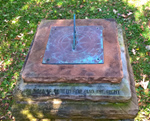 |
Nashotah |
Wisconsin |
USA |
Horizontal Dial |
Dial 845 |
| In a quite, shaded corner of the Nashotah House Theological Seminary is a copper alloy horizontal dial. The dial plate is a 10 inch square, 3/32 inches thick. The dial is engraved with several concentric circles with with large Roman hour marks on an outer ring from 5am to 7pm. Time is delineated in 5 minute increments on the outer circle, but includes an inner circle delineated in 15 minute increments. In the center of the dial is an 8-point compass rose with engraved directions. The quarter inch thick brass gnomon is a simple raised bar acting as style with an "S" shaped support. |
| |
| |
 |
Baltimore |
Maryland |
USA |
Analemmatic Dial |
Dial 844 |
| Volunteers painted a 16 x 5 foot analemmatic dial for the elementary and middle school students. The dial has 8-inch circles for hour numbers from 5am to 7pm using standard time. The dial walkway is painted with yellow month lines and abbreviations for each month to the side. The words "summer" and "winter" are at the solstice lines. Bailey points are painted as small yellow circles to indicate the direction of sunrise and sunset from the observer's position on the walkway. |
| |
| |
 |
Baltimore |
Maryland |
USA |
Analemmatic Dial |
Dial 843 |
| Volunteers painted a 16 x 5 foot analemmatic dial for the elementary and middle school students. The dial has 8-inch circles for hour numbers from 5am to 7pm using standard time. The dial walkway is painted with yellow month lines and abbreviations for each month to the side. The words "summer" and "winter" are at the solstice lines. Bailey points are painted as small yellow circles to indicate the direction of sunrise and sunset from the observer's position on the walkway. |
| |
| |
 |
Ocean Shores |
Washington |
USA |
Horizontal Dial |
Dial 842 |
| This large horizontal dial has a gnomon in the shape of an anchor and concrete minimalist dial surface in the shape of a triangle, keeping the theme of the location "Triangle Park". Three time Arabic hour numbers of 9, 12 and 3 are embedded into the concrete slab and two other time marks of 6am and 6pm are on separate pads located outside the main dial area. |
| |
| |
 |
Milwaukee |
Wisconsin |
USA |
Vertical Dial |
Dial 841 |
| This large vertical south facing sundial is fabricated from aluminum. Eight slender hour lines delineate the time. At the top of the hour lines along the winter solstice are acrylic numbers on the circular hour plates showing time from 10am to 5pm. At the bottom of the hour lines along the summer solstice are additional acrylic numbers showing daylight saving time from 11am to 6pm. A short horizontal bar shows the equinox. |
| |
| |
 |
Sheridan |
Wyoming |
USA |
Horizontal Dial |
Dial 840 |
| This monumental horizontal dial is 15 ft. in diameter sitting on a foundation of poured concrete and rebar. The dial face is etched on 4 large granite slabs from Canada. The gnomon is a 6-inch diameter steel pipe 97inches tall with a welded nodus ball and a triangular sheet beneath the gnomon that has a sun and the school logo (a mountain range) cut into it casting projected images onto the sundial face. |
| |
| |
 |
Twin Falls |
Idaho |
USA |
Equatorial Dial |
Dial 839 |
| This beautiful stainless steel equatorial is approximately 1m in diameter with brass inlay for the equatorial time, divided down to the minute. This is also an analemmic sundial where the brass gnomon is cut out in the shape of an analemma allowing the user to directly correct for the equation of time. The analemma is marked with 365 individual date marks. |
| |
| |
 |
South Lee |
Massachusetts |
USA |
Vertical Dial |
Dial 838 |
| On the transom of a brown wood shingled and stone building that looks like it once was a church is a vertical south declining wooden sundial about 2 x 2 feet square. The sundial is painted red with a nicely cut wood gnomon. Hour lines and Roman numerals from VI to VI are chiseled into the wood, along with an inscription. The dial is framed in wood as well but the contrasting grey paint is flaking off. |
| |
| |
 |
Bloomfield Hills |
Michigan |
USA |
Horizontal Dial |
Dial 837 |
| In Cranbrook Gardens, where works of art topiary and American crafts are displayed, one can find a brass horizontal dial transformed into a beautiful sculpture of a ginkgo leaf with the stem serving as the style. Hour lines are the radiating leaf veins. A small circle with Arabic numbers delineates each hour from 6am to 6pm..The ginkgo leaf sundial is about 40 cm and the height of the tail about 14 cm. The sundial hour circle is about 20 cm in diameter. |
| |
| |
 |
St. Louis |
Missouri |
USA |
Horizontal Dial |
Dial 836 |
| A horizontal sundial made on an octagonal brass plate, measuring 12 inches from side to side. The engraved hour lines are divided with marks for half, quarter and eighth parts of the hour. The hour numbers themselves are outward facing Roman numerals. The brass gnomon is bent slightly to the west by vandals. The pedestal is 37.5 inches tall with a 17 inch circular top cap of pink marble. Unfortunately the dial is located near a tree, so it is in shade for part of day. |
| |
| |
 |
State College |
Pennsylvania |
USA |
Analemmatic Dial |
Dial 835 |
| A simple analemmatic dial about 12 feet across. Square unmarked flagstone or pavers mark the hours. The walkway has a concrete base covered by the same flagstone or pavers. The walkway months are embossed in the stone. |
| |
| |
 |
Lucedale |
Mississippi |
USA |
Analemmatic Dial |
Dial 834 |
| This analemmatic dial (sometimes called a human sundial) is designed for children. Approximately 16 ft wide, it is constructed of red brick with steel hour marks. The numbers for standard time are large silver and the numbers for daylight saving time are smaller and black. A black steel walkway is located in the center of the dial with embossed months of the year. Children stand on the month. Their shadow marks the time. Large numbers are standard time. Small numbers are daylight saving time. |
| |
| |
 |
Ottawa |
Ontario |
Canada |
Horizontal Dial |
Dial 833 |
| A garden variety round horizontal sundial about 12 inches in diameter. It looks like a bronze casting with iron staining from steel bolts. Hours marks only from VI to VI (6 am to 6 pm). The dial is located in a very shaded spot close to a building and surrounded by trees. Ornamental. Dial plate has inscription "Tempus Omnia Revelat" (Time Reveals All). |
| |
| |
 |
Hanover |
New Hampshire |
USA |
Vertical Dial |
Dial 832 |
| This octagonal vertical sundial is mounted on the due south facing wall of Shattuck Observatory. The dial is painted on wood. The hours are VI to VI (6 am to 6 pm) with lines for half and quarter hours. The thick triangular gnomon is rigidly mounted on the dial face. The dial is in excellent mechanical condition but the paint is flaking badly due to sun and weather exposure. |
| |
| |
 |
Portland |
Maine |
USA |
Equatorial Dial |
Dial 831 |
| Prominent in the cemetery is a large equatorial sundial about 4 ft in diameter. The dial was custom built for the location latitude and longitude. It is made of cast, anodized aluminum. The equatorial ring is 8-inch side arc with Roman numeral hours from VI to VI (6am to 6pm) with marks at 5 minute intervals. The scale is shifted to correct for longitude. The gnomon is an elegant arrow. It sits on a 4 ft plinth made of river stone, capped with a circular 6 inch block of polished granite. |
| |
| |
 |
Brunswick |
Maine |
USA |
Horizontal Dial |
Dial 830 |
| In the shade of many trees is a 12 inch circular horizontal sundial sitting on a square granite plinth. The dial plate shows solar time with Roman numerals V to VII (5am to 7pm). Half and quarter hours are shown with dots. |
| |
| |
 |
Falmouth |
Maine |
USA |
Armillary Sphere |
Dial 829 |
| This bronze armillary sundial is about 18 inches in diameter. The prime meridian ring is embossed with an intricate design. A different designed with forward and backward "S" adorns the exterior of the equatorial ring while the interior has embossed Roman numerals for the the hours. The 6-hour ring is plain and there is no horizontal ring. The arrow gnomon rod is at the correct slope but the dial is free to turn on its base so that it is not oriented north. |
| |
| |
 |
Stanbridge East |
Quebec |
Canada |
Horizontal Dial |
Dial 828 |
| The sundial is a 10-inch circular bronze horizontal dial engraved with hours in Roman numerals from IIII to VIII, (4 am to 8 pm) and marks for the half and quarter hours. A compass rose shows 32 compass points. Unfortunately the gnomon is missing. It was originally fastened by two weak screws. Attempts to solder the gnomon in place failed. |
| |
| |
 |
Ottawa |
Ontario |
Canada |
Horizontal Dial |
Dial 827 |
| This sundial is a memorial for W T Macoun. The dial is a simple bronze horizontal sundial, about 12 inches in diameter. It shows solar time with hour lines from 4 am to 8 pm. Hour marks are Roman numerals. The design accounts for the thick gnomon. The stone octagonal base is about 40 inches high |
| |
| |
 |
Kokomo |
Indiana |
USA |
Equatorial Dial |
Dial 826 |
| This is a hammered wrought iron equatorial sundial approximately 30 inches in diameter with a 6 inch equatorial band. The gnomon is a thin rod bracketed by an iron slit that is manually rotated to allow a bright beam of light to surround the shadow time-telling mark. The dial is designed to show local solar time, and requires the Equation of Time to correct for the tilted earth’s rotation axis and its eccentric orbit around the sun. |
| |
| |
 |
Tucson |
Arizona |
USA |
Analemmatic Dial |
Dial 825 |
| This nearly 14-foot wide analemmatic human sundial replaces the previous sundial at the same location. The previous dial by an unknown designer had several design errors and was in poor condition. The Flandrau Planetarium replace it, choosing a sundial with a blue background and white hour numerals. Dial Markings include quarter hour marks, Solar Noon Mark, Date Line with one week marks, Alignment Marker for Sunrise and Sunset (Bailey Points) with Solstice and Equinox lines, and the four Cardinal Points of the compass. The dial has a built-in longitude correction and shows Mountain Standard Time when readings are adjusted for The Equation of Time |
| |
| |
 |
Santa Cruz |
California |
USA |
Globe or Hemispheric |
Dial 824 |
| This is a globe dial with a twist: a glass sphere is used to represent the earth with continent lines scribed on the globe along with hour lines, analemma figure for each hour, tropic of cancer, tropic of capricorn, equator, and a line representing the local horizon. The globe is etched with the dial site at the globe's zenith. The dial has a central gnomon. When the shadow of a pointer falls on the gnomon the time is read using the correct side of the hour line analemma. |
| |
| |
 |
Rockville |
Maryland |
USA |
Horizontal Dial |
Dial 823 |
| A simple stainless steel gnomon 5-inches in diameter sits on a 6-foot concrete dais. Surrounding the dais are brick pavers with two circular bands of granite pavers. The interior band is for daylight saving time hours of engraved numbers filled with a gold color and a similar outer band for standard time hours. The granite pavers also mark the cardinal points engraved in gold, and extended as east-west and north-south lines from the dais. What makes this dial both unique and beautiful is the low brick and concrete surrounding walls with inscriptions from famous authors on both the interior and exterior faces. |
| |
| |
 |
St. Petersburg |
Florida |
USA |
Analemmatic Dial |
Dial 822 |
| Sculptor Eric Higgs was originally approached by Robin Reed,who chaired the historic preservation committee for the Historic Old Northeast Neighborhood Association. She was interested in sprucing up a decrepit area where sundials once stood at Vista Point, Flora Park. From the 1930's to the 1970's two different sundials were located on this site. The plan to refurbish the last sundial slowly evolved into a plan for a new sculpture that "escalated into a project for the [waterfront] centennial." |
| |
| |
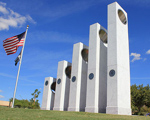 |
Anthem |
Arizona |
USA |
Sun Alignment |
Dial 821 |
| The Anthem Veterans Memorial in Anthem, AZ was dedicated on November 11, 2011 at 11am (11-11-11) to honor the service and sacrifice of the United States armed forces and to provide a place of honor and reflection for veterans, their family and friends. Veterans gather here annually on November 11th to watch a solar alignment at 11:11am when the sun precisely illuminates a 3-foot medallion of The Great Seal of the United States. |
| |
| |
 |
Lucedale |
Mississippi |
USA |
Sun Alignment |
Dial 820 |
| This is a Veteran's Memorial consisting of a set of five large stainless steel panels with holes that guide sunlight to strike a memorial plaque. The alignment is designed to commemorate the signing of the armistice ending World War One, illuminating the plaque on Nov 11th at 11:00AM |
| |
| |
 |
Morristown |
New Jersey |
USA |
Analemmatic Dial |
Dial 819 |
| This analemmatic dial is approximately 20 feet wide by 12 feet long, constructed of reinforced, high strength cast-in-place concrete. Showing both Standard and Daylight Savings Time, the dial uses a dual ring of twenty-eight circular hour markers. Each hour marker is a 12 inch diameter precast paver flush with the surrounding landscaping with an aluminum Arabic hour numeral on top. |
| |
| |
 |
Portland |
Maine |
USA |
Horizontal Dial |
Dial 818 |
| A large 1m (3-foot) bronze sundial is set on a low granite dais at the center of a white granite ellipse. Surrounding the sundial are three white granite benches, the center declaring this as a memorial to Mayor James Baxter. The hour ring gives the hours from V in the morning to VII in the evening The ring is further divided into 15 minute increments. The dial has a large 24-point star and on the south end of the dial face the words "Baxter Boulevard". The artful gnomon is about 1-inch thick. Unfortunately the monument setting is heavily wooded and little sunlight reaches this fine dial. |
| |
| |
 |
New Milford |
Connecticut |
USA |
Equatorial Dial |
Dial 817 |
| This 9-foot stainless steel equatorial is the centerpiece of "Galileo's Garden". The sundial was built and dedicated in memory of Kathleen Fischer, a sixth-grade science teacher who inspired many students to pursue science. The sundial is an open armillary, with an adjustable hour band so that both local solar time and civil time can be read. At the tip of the gnomon is a bronze and brass true-size rendering of Galileo’s first telescope, honoring the 400 years since Galileo explored the heavens. The North American Sundial Society was privileged to donate to this effort. |
| |
| |
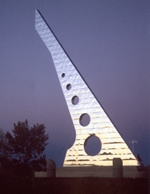 |
Grande Prairie |
Alberta |
Canada |
Horizontal Dial |
Dial 816 |
| This monumental stainless steel sundial was built as part of the Grande Prairie Millennium Project. The beautiful gnomon is 12m (40-feet) tall and symbolizes the passage of the year 2000 into the 21st century. Behind the visible stainless steel cover of the sundial's gnomon is a one by two foot steel beam. Engineers adopted computer programming techniques to construct and align the 30 centimetre thick gnomon of the Centre 2000 sundial. Specific factors such as the city’s elevation, its latitude and correction longitude mark time with the region’s Mountain Standard and Daylight Savings Time. |
| |
| |
 |
San Diego |
California |
USA |
Equatorial Dial |
Dial 815 |
| This broad band equatorial dial was dedicated in 1978 to George A. Koester, former Executive Dean of San Diego State University. The approximately 3-foot dial is on a brick pedestal situated on on a small dais. Concentric brick circles complete the large dial plaza. |
| |
| |
 |
Leisure City |
Florida |
USA |
Obelisk or Vertical Gnomon |
Dial 814 |
| Amid the many coral blocks (oolitic limestone rock) carved by eccentric Edward Leedskalnin (1887-1951) is a huge monolithic sundial. The gnomon is a horizontal L-shaped piece of iron fastened to the north corner of a limestone block about 8 feet high, weighing about 15 short-tons. Below the gnomon, carved into a second block of limestone is a portion of a hemisphere, smoothly filled in with concrete. Drawn on the hemisphere are analemma shaped hour and half-hour lines from 9am to 4pm. You can read the time with an accuracy of about two-minutes. |
| |
| |
 |
Victoria |
British Columbia |
Canada |
Horizontal Dial |
Dial 813 |
| This brass horizontal sundial was designed and engraved for use in the town of Hope BC by British Royal Engineers in 1860. The circular dial is 8 inches diameter with a triangular gnomon. Time lines are engraved at 15 minute intervals from 4 am to 8 pm. The dial is on display in the museum beside other survey instruments and the red uniform of a Royal Engineers Sergeant. |
| |
| |
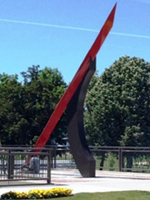 |
Coeur d'Alene |
Idaho |
USA |
Horizontal Dial |
Dial 812 |
| In 2013 the city of Coeur d'Alene began a $20M renovation of downtown McEuen Park, a 22-acre expanse, to include a large sundial. But shortly after the renovation started, the city commissioners were told the $51,000 that was to be spent on the sundial was instead to be used to install heavier electrical infrastructure for support of major park events. Fortunately by the end of 2013, the City Staff announced that the sundial was added back to the park's plan, made possible by a $50,000 donation from Parkwood Business Properties. |
| |
| |
 |
Elmira |
New York |
USA |
Vertical Dial |
Dial 811 |
| The white concrete dial face with surrounding dark red Arabic hour numbers is approximately 2 foot tall by 4 foot wide. The hour angles are clean grooves in the concrete. All are easily visible from ground level. Most striking is the steel gnomon painted bright yellow with an ornate central cut-out of a triangle symbolizing the trinity. |
| |
| |
 |
Elmira |
New York |
USA |
Sun Alignment |
Dial 810 |
| This solar alignment sculpture called the "Sun Triangle" is made of polished 1/8 inch stainless steel. Its leaning, 10 foot tall pedestal gives the mounted triangle a futuristic look of monumental size, where the tip of the triangle towers 34 feet above ground level. The selected triangle angles are described by the dial plaque, making solar alignments at noon on the equinoxes and summer/winter solstices. There are no line markings or hour indicators on the ground. However, the pedestal is bolted to a buried concrete block weighing approximately 16 tons. |
| |
| |
 |
Oliver |
British Columbia |
Canada |
Horizontal Dial |
Dial 809 |
| A lovely horizontal dial with an 8-foot high stainless steel gnomon. The hour lines are done as colorful alternating red and cream segments set in a 8-foot radius semi-circle. The gnomon is triangular in cross section with a single thin edge casting the shadow. The dial hour numbers are set for daylight, since all of the winery's 100,000 annual visitors are seasonal, coming when Pacific Daylight Time is in place. |
| |
| |
 |
Dover |
Massachusetts |
USA |
Horizontal Dial |
Dial 808 |
| The horizontal dial is in the spiral shape of a Nautilus. The dial was originally built in the 1920's and located at Amelia Peabody's Sun House at 145 Powisset Stree in Dover, MA. |
| |
| |
 |
Winterthur |
Delaware |
USA |
Horizontal Dial |
Dial 807 |
| A bronze horizontal sundial about 18 inches in diameter. The Arabic hour numbers range from 4am to 8pm, with time delineated into half, quarter, and eighth hours. A side photo of the gnomon shows it is set for about 53° and the top-down photo of the dial (corrected for perspective) confirms this. A DuPont purchase in England? |
| |
| |
 |
Winterthur |
Delaware |
USA |
Armillary Sphere |
Dial 806 |
| The 59" armillary is located in the Sundial Garden, designed by Landscape Designer Marian Coffin for Henry Francis DuPont for the family's former tennis court in 1955. It features an antique armillary sundial weighing 70 pounds. It was collected by the DuPont family between 1850-1920. |
| |
| |
 |
Lake Forest |
Illinois |
USA |
Vertical Dial |
Dial 805 |
| A vertical south-facing dial, simple in design and visible to the shoppers in the U-shaped town square below. The dial face is plane white with Roman hour numbers fastened to a rod bent in an ellipse. No other delineation (such as solstice and equinox lines) is on the dial face. The gnomon is a simple rod held by an "S" shaped support. |
| |
| |
 |
Logan |
Utah |
USA |
Analemmatic Dial |
Dial 804 |
| Work to design and make the Analemmatic Sundial was done by students of the sixth grade science class and teacher Eric Newell in 2005. The central walkway uses stepping stones sandblasted with the name of the months. John Westenskow's ceramics classes at Mount Logan Middle School made the time stones. Students surveyed and plotted the location of the stones and provided the physical labor to dig holes and pour cement. |
| |
| |
 |
Pennington |
New Jersey |
USA |
Cylindrical Dial |
Dial 803 |
| This is an adaptation of the dual cylindrical sundial design by Hoffmann Albin of Butgenback, Belgium that provides for two separate dials to be displayed. In this variation, the two dials are separately displayed after being rotated and locked into viewing position every six months on the solstices. Except for two bronze sleeve bearings, all parts are 304 stainless steel that has been glass bead blasted to reduce reflection, machined, welded or laser cut. The analemmal hour lines, equinox and month lines are laser etched into the stainless steel dial plates. The dials and their supporting cradles are 12 gauge with 12" diameters. The post is 1.75" in diameter. |
| |
| |
 |
Round Lake Beach |
Illinois |
USA |
Horizontal Dial |
Dial 802 |
| This is an octagonal-shaped horizontal dial 240 mm (9.5 inches)across. The photo-etched plate has a central compass rose and delineated with a half hour circle and second circle dividing the time into quarter-hour increments. Roman numerals mark the hours from 6am to 6pm, with an extra hour mark to extend the dial's time-telling from 5am to 7pm. The dial is adjusted for the longitude of the site. Atop the dial face is a sturdy filigree gnomon approximately 5mm wide and 90mm (3.5 inches) high. South of the gnomon is a graphic Equation of Time. |
| |
| |
 |
Mesa |
Arizona |
USA |
Analemmatic Dial |
Dial 801 |
| This concrete analemmatic dial is set is a larger concrete plaza located in a City park with an overall theme of Sonoran Desert environmental education and nature-based play. |
| |
| |
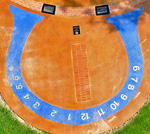 |
Magnolia |
Arkansas |
USA |
Analemmatic Dial |
Dial 800 |
| A 22 by 17 foot analemmatic dial of stained concrete with Arabic hour numerals of polished brass. The dial perimeter and hour numerals are set in a blue decorative polymer "U" arc, appearing as a large mule shoe that represents the university Muleriders mascot symbol. Dial colors represent the royal blue and gold school colors. |
| |
| |
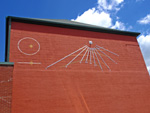 |
Wooster |
Ohio |
USA |
Vertical Dial |
Dial 799 |
| A vertical dial on a 15 x 40 foot section of a second story brick wall declining 11° east. The gnomon, hour lines and 7 am to 4 pm Arabic hour numerals are aluminum. |
| |
| |
 |
Georgetown |
District of Columbia |
USA |
Vertical Dial |
Dial 798 |
| A vertical dial, perhaps one foot square, above the front door of the Georgetown University Astronomical Observatory (the Hayden Observatory). The dial face has Roman hour numerals near its perimeter. |
| |
| |
 |
Cranford |
New Jersey |
USA |
Horizontal Dial |
Dial 797 |
| A 15 foot diameter horizontal dial with 5 foot high welded stainless steel plate gnomon. The dial face is elevated 18 inches by a white marble-faced platform above a 50 foot diameter concrete plaza that includes inset stainless steel hour line extensions. The dial face is rimmed with Bluestone and has elevated stainless steel hour lines for 4 am to 8 pm and elevated three inch stainless steel Arabic hour numerals. Cardinal directions are marked with elevated 6 inch stainless steel letters. |
| |
| |
 |
Shoreline |
Washington |
USA |
Analemmatic Dial |
Dial 796 |
| An 8 foot diameter concrete and pebble analemmatic dial with engraved stainless steel inserts for central date line and simple instructions for use. The dial face is raised one foot on a fluted column above the perimeter concrete and stainless steel walkway and has stainless steel Arabic hour numerals for 6 AM, 12 PM and 6 PM. The walkway has stainless steel inserts showing hour lines, magnetic north, true north, winter solstice, equinox and summer solstice directions. |
| |